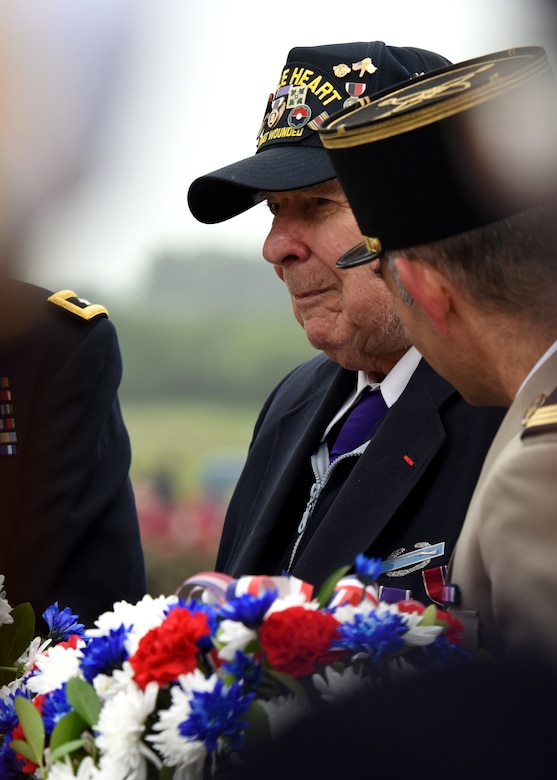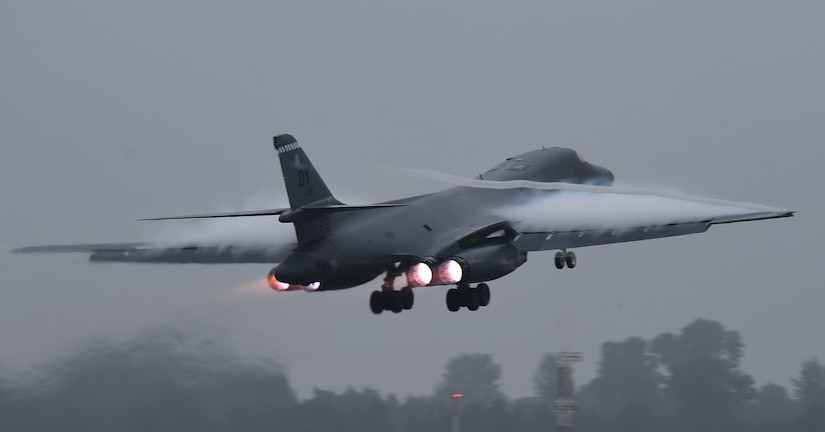By Army Staff Sgt. Tamika Dillard, U.S. Army Europe
SAINTE-MARIE-DU-MONT, France -- On June 6, 1944, more than
156,000 troops began the largest multinational amphibious landing and
operational military airdrop in history.
And 74 years later, the eyes of the world still look upon
them as U.S. service members, World War II veterans, NATO allies and partners
participated in events and ceremonies throughout the Normandy region of France
to honor the bravery, heroism, selfless service and sacrifices of the Greatest
Generation.
Today marks the 74th anniversary of Operation Overlord, the
Allied invasion of Normandy, most commonly known as D-Day. An epic
multinational amphibious and airborne operation, D-Day forged partnerships and
reinforced trans-Atlantic bonds that remain strong to this day. U.S. service
members from 20 units in Europe and the United States have commemorated the
D-Day anniversary over the past week in almost 40 locations throughout the
Normandy region.
Events such as the Carentan Battlefield Tour; wreath-laying ceremonies
at the Airborne, General Eisenhower, Point du Hoc and Iron Mike monuments; and
the addition of the 101st Airborne Division’s football “game that never
happened” took place throughout the commemorative week.
Utah Beach Ceremony
Today, a wreath-laying ceremony at the Utah Beach Federal
Monument here featured remarks by U.S. Ambassador to France Jaime McCourt and
D-Day veteran Steve Melnikof.
Melnikof, 98, briefly recounted an event from the day his
unit, the 29th Infantry Division, stormed Omaha Beach.
“That day alongside us were the French, English, Canadians
and the British,” Melnikof said. “We had an assignment to get over this high
bluff, and we did. We lost a lot of infantrymen that day, … but we will
remember them all as combat infantrymen.”
Speaking in French, McCourt lauded the bravery, heroism,
selfless service and sacrifice that Melnikof and other D-Day veterans gave for
the freedoms enjoyed today.
A Generation’s Defining Moment
“The acts of the Allies on Utah Beach and the other beaches
that morning in June were far more than heroic. … They were the defining moment
of a whole generation,” she said. “They changed the course of world history.”
Switching to English, McCourt then addressed the World War
II veterans in the audience.
“Proclamations are easily made,” she said. “Turning words
into reality requires the effort and sacrifice of the truly great men and women
like you. Thank you for being there then, and thank you for being here.”
Stories of bravery, heroism, selfless service and sacrifice
will continue to be passed on from generation to generation as a way of
honoring the past to secure the future.
“Ceremonies such as this are more than just commemorations,”
the ambassador said. “They are the spirit of our story, which we pass on to the
new generation. It is our children and the children of our children who will
take responsibility for maintaining and consolidating this world of peace and
freedom for tomorrow, as well as the bonds of friendship between our two
nations.”
Commemorative Events Mark 74th Anniversary of D-Day
By Army Staff Sgt. Tamika Dillard, U.S. Army Europe
SAINTE-MARIE-DU-MONT, France -- On June 6, 1944, more than
156,000 troops began the largest multinational amphibious landing and
operational military airdrop in history.
And 74 years later, the eyes of the world still look upon
them as U.S. service members, World War II veterans, NATO allies and partners
participated in events and ceremonies throughout the Normandy region of France
to honor the bravery, heroism, selfless service and sacrifices of the Greatest
Generation.
Today marks the 74th anniversary of Operation Overlord, the
Allied invasion of Normandy, most commonly known as D-Day. An epic
multinational amphibious and airborne operation, D-Day forged partnerships and
reinforced trans-Atlantic bonds that remain strong to this day. U.S. service
members from 20 units in Europe and the United States have commemorated the
D-Day anniversary over the past week in almost 40 locations throughout the
Normandy region.
Events such as the Carentan Battlefield Tour; wreath-laying ceremonies
at the Airborne, General Eisenhower, Point du Hoc and Iron Mike monuments; and
the addition of the 101st Airborne Division’s football “game that never
happened” took place throughout the commemorative week.
Utah Beach Ceremony
Today, a wreath-laying ceremony at the Utah Beach Federal
Monument here featured remarks by U.S. Ambassador to France Jaime McCourt and
D-Day veteran Steve Melnikof.
Melnikof, 98, briefly recounted an event from the day his
unit, the 29th Infantry Division, stormed Omaha Beach.
“That day alongside us were the French, English, Canadians
and the British,” Melnikof said. “We had an assignment to get over this high
bluff, and we did. We lost a lot of infantrymen that day, … but we will
remember them all as combat infantrymen.”
Speaking in French, McCourt lauded the bravery, heroism,
selfless service and sacrifice that Melnikof and other D-Day veterans gave for
the freedoms enjoyed today.
A Generation’s Defining Moment
“The acts of the Allies on Utah Beach and the other beaches
that morning in June were far more than heroic. … They were the defining moment
of a whole generation,” she said. “They changed the course of world history.”
Switching to English, McCourt then addressed the World War
II veterans in the audience.
“Proclamations are easily made,” she said. “Turning words
into reality requires the effort and sacrifice of the truly great men and women
like you. Thank you for being there then, and thank you for being here.”
Stories of bravery, heroism, selfless service and sacrifice
will continue to be passed on from generation to generation as a way of
honoring the past to secure the future.
“Ceremonies such as this are more than just commemorations,”
the ambassador said. “They are the spirit of our story, which we pass on to the
new generation. It is our children and the children of our children who will
take responsibility for maintaining and consolidating this world of peace and
freedom for tomorrow, as well as the bonds of friendship between our two
nations.”








